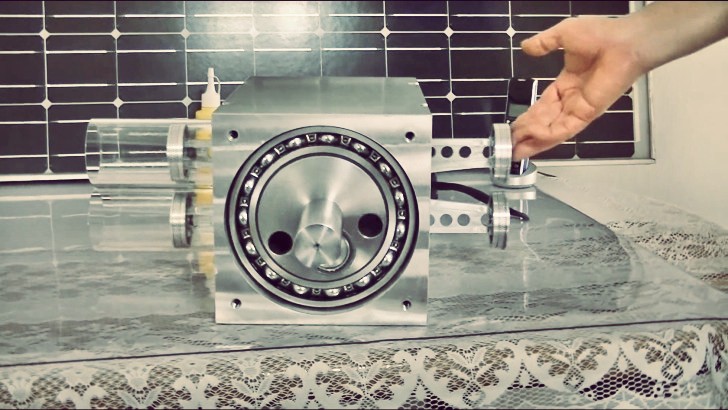Despite being in use for more than a century, combustion engines are still way to complex and inefficient in turing fossil fuel to mechanical work. Naturally, engineers have been battling their way through to solve this problem since day one, making compromises and even coming up with different conceptual constructions. Which takes us to this unusual combustion engine concept here.
Current four-cylinder turbocharged combustion engines might seem like tiny engineering miracles, managing to pack quite a big punch for their size while still averaging a reasonable fuel consumption. Even so, a maximum of 40 percent of the energy released by the fuel is used to move the vehicle, with the rest being lost through heat and internal friction.
Japan based company Namikoshi Electronics has come up with a solution to boost that efficiency factor - a four-cylinder engine that basically has one huge piston.
Namikoshi’s engine on the other hand uses a construction similar to a boxer engine but with a huge difference. It still has four pistons, but instead of each going up and down separately, they’re all interconnected and act like one giant piston that moves from left to right into the two banks of cylinders.
The linear oscillating motion is converted then into a continuously rotational one via a planetary gearset and ball bearings, which can further reduce friction.
Here, the pistons’ kinetic energy directly offsets the balancer’s, therefore the energy doesn’t go through the piston and crank pins to be transmitted to the “crankshaft”. Simply put, there’s no friction caused and therefore there are no energy losses.
Due to all four pistons being connected as one, the expansive power is directly transmitted from one piston to the other three (unlike in a normal engine where it has to go through the pins first) which again reduces energy loss.
Ultimately, vibrations are being kept at a very low level thanks to the coherent rotation between dynamic and static balance. Namikoshi brags about its engine running as smooth as a rotary one.
Doesn’t seem impressive, since you could easily achieve such an average even with a 1.9 TDI Volkswagen Golf Mk 5, but then, maybe this engine offers more than 105 hp at the crankshaft.
The engine weighs about 90 kg (198 lbs) and measures 800 mm (31.5 inch) in width, 250 mm (9.8 inch) in depth and 500 mm (19.7 inch) in height. Each cylinder has a 62 mm bore and a 125 mm stroke, all summing up to about 1,500 cc (91.5 cui).
Japan based company Namikoshi Electronics has come up with a solution to boost that efficiency factor - a four-cylinder engine that basically has one huge piston.
Confusing but technically true
Your average engine today has every piston connected to the crankshaft via rods and oil lubricated bearings to somehow minimize the friction and wear created as linear motion is converted into a rotating one at the shaft. It’s a complex structure and adds up to the number of internal moving parts, thus representing an energy-eating system.Namikoshi’s engine on the other hand uses a construction similar to a boxer engine but with a huge difference. It still has four pistons, but instead of each going up and down separately, they’re all interconnected and act like one giant piston that moves from left to right into the two banks of cylinders.
The linear oscillating motion is converted then into a continuously rotational one via a planetary gearset and ball bearings, which can further reduce friction.
Advantages
First of all, you obviously get a lot less interconnected parts that create friction when moving. Then, there’s the removal of round-trip kinetic energy creating by the pistons’ reciprocating motion.Here, the pistons’ kinetic energy directly offsets the balancer’s, therefore the energy doesn’t go through the piston and crank pins to be transmitted to the “crankshaft”. Simply put, there’s no friction caused and therefore there are no energy losses.
Due to all four pistons being connected as one, the expansive power is directly transmitted from one piston to the other three (unlike in a normal engine where it has to go through the pins first) which again reduces energy loss.
Ultimately, vibrations are being kept at a very low level thanks to the coherent rotation between dynamic and static balance. Namikoshi brags about its engine running as smooth as a rotary one.
Specs
We would love to tell you about how capable this thing is, but the company only revealed that it’s efficiency matches a hybrid powertrain. So if you do a quick math and cross your fingers for the best, the four-in-one-piston engine could probably match the Prius’ average fuel consumption, which is currently rated at an estimate of 51 mpg (4.6 l/100 km).Doesn’t seem impressive, since you could easily achieve such an average even with a 1.9 TDI Volkswagen Golf Mk 5, but then, maybe this engine offers more than 105 hp at the crankshaft.
The engine weighs about 90 kg (198 lbs) and measures 800 mm (31.5 inch) in width, 250 mm (9.8 inch) in depth and 500 mm (19.7 inch) in height. Each cylinder has a 62 mm bore and a 125 mm stroke, all summing up to about 1,500 cc (91.5 cui).





